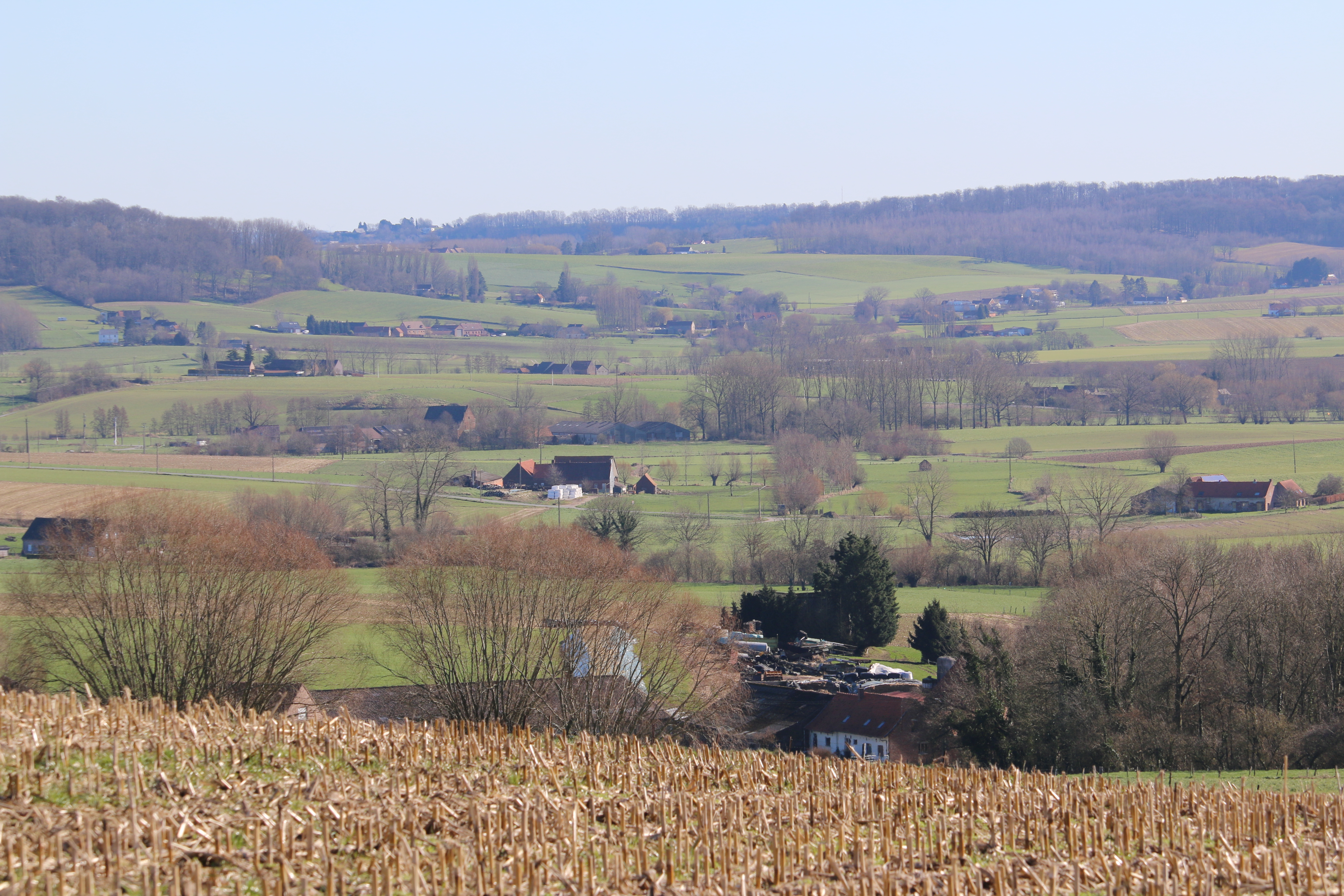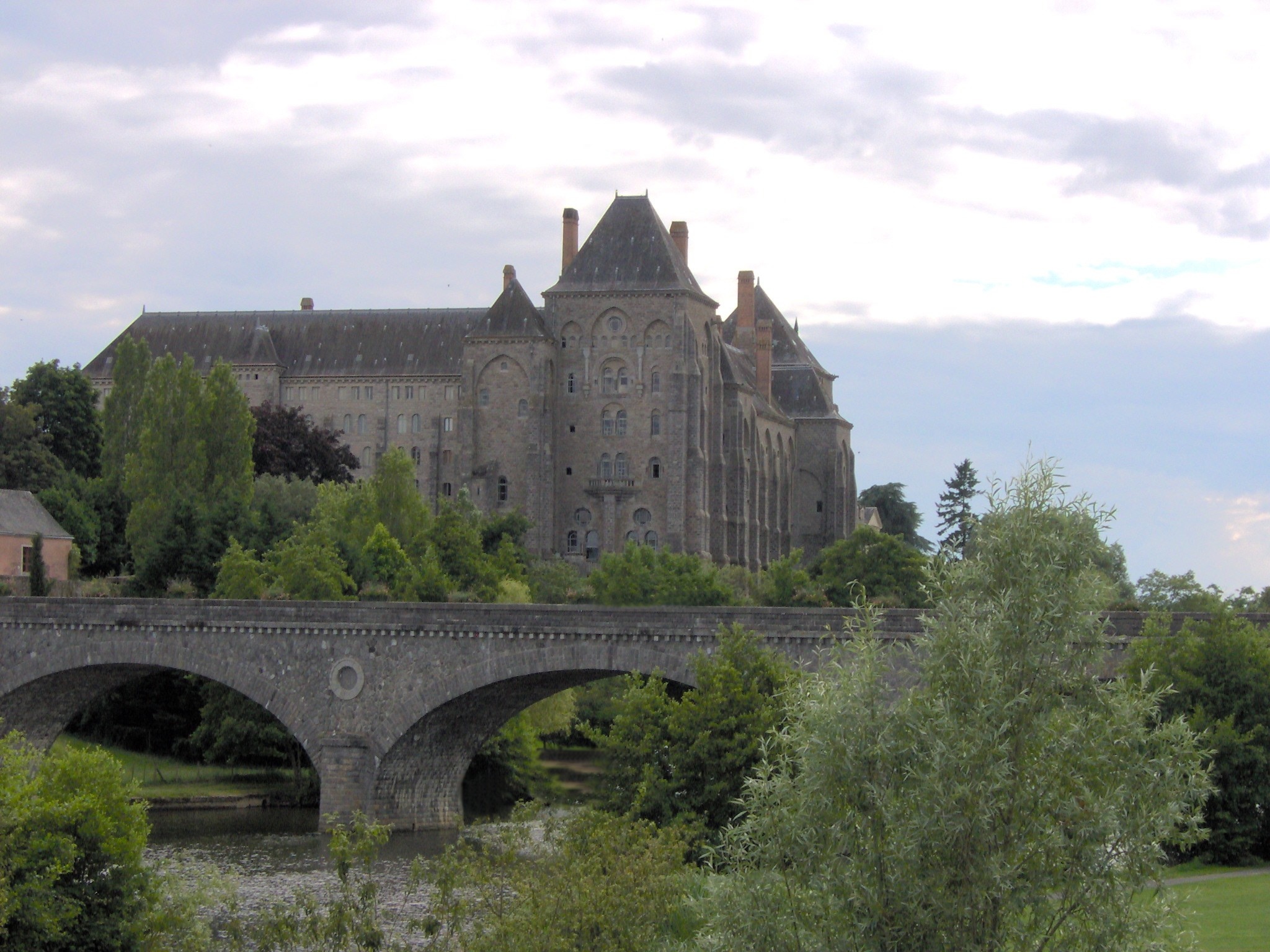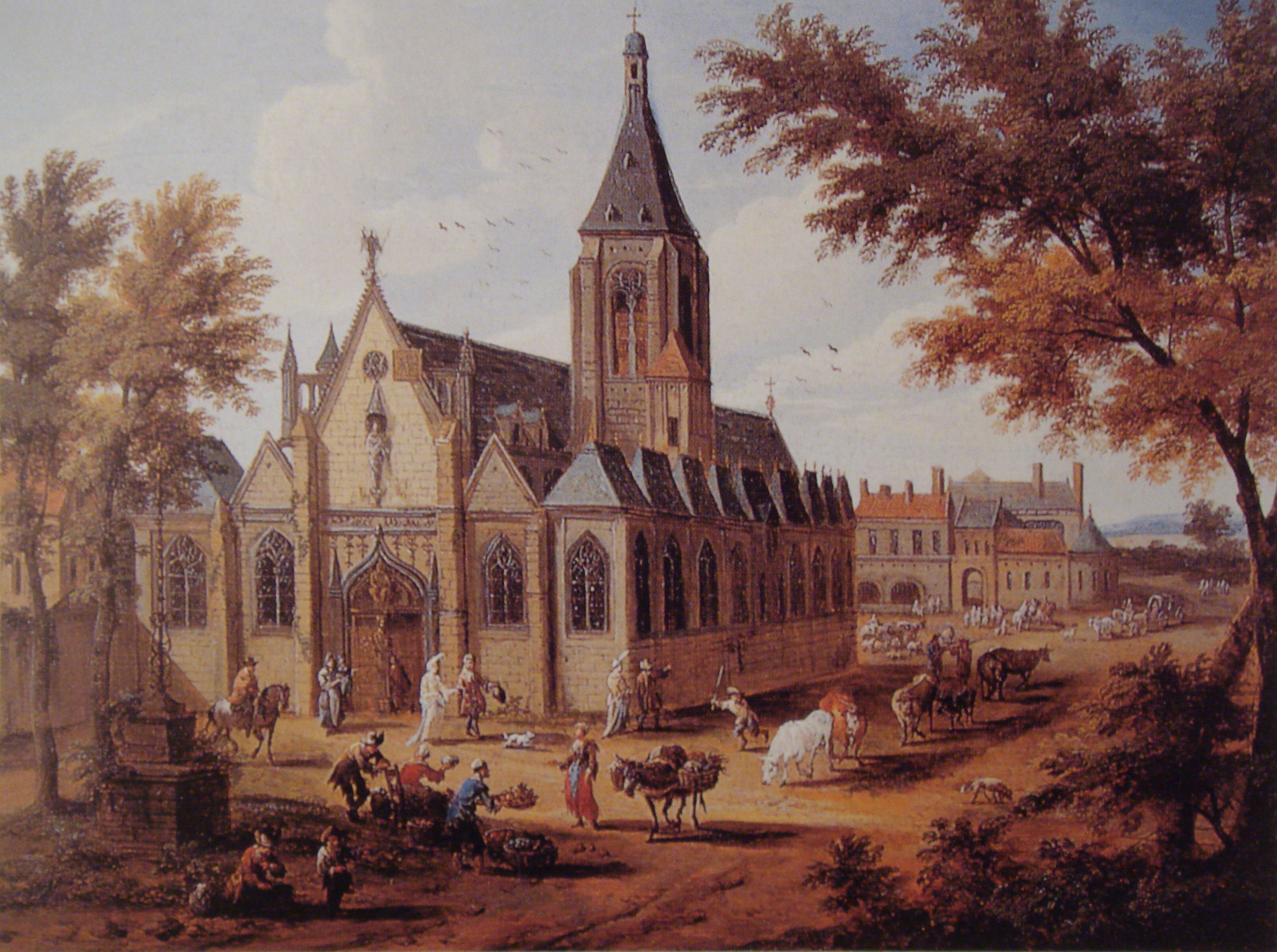|
Louis Lambillotte
Louis Lambillotte (born La Hamaide, ( Hainaut, Belgium), 27 March 1796; died Paris, 27 February 1855) was a Belgian Jesuit, composer and palaeographer of Catholic music, associated with the restoration of Gregorian music, which he inaugurated and promoted by his scientific researches and publications. Early life Louis Lambillotte was born at La Hamaide, near Charleroi and began studying solfège, piano, and harmony at the age of seven. At the age of fifteen, he became organist in Charleroi; later he went in a similar capacity to Dinant (Belgium). In 1820 he was appointed choirmaster and organist of the Jesuit College of Saint-Acheul, Amiens. While exercising these functions he also studied the classics, and at the end of five years, in August, 1825, he entered the Society of Jesus. The thirty years of his Jesuit life were spent successively in the colleges of Saint-Acheul, Fribourg, Estavayer, Brugelette and Vaugirard (Paris). While occupied in teaching and directing music, he ... [...More Info...] [...Related Items...] OR: [Wikipedia] [Google] [Baidu] |
Hainaut (province)
Hainaut ( , also , ; ; ; ; ), historically also known as Heynault in English, is the westernmost Provinces of regions in Belgium, province of Wallonia, the French-speaking region of Belgium. To its south lies the France, French department of Nord (French department), Nord, while within Belgium it borders (clockwise from the north) on the Flemish Region, Flemish provinces of West Flanders, East Flanders, Flemish Brabant and the Walloon provinces of Walloon Brabant and Namur Province, Namur. Its capital is Mons, Belgium, Mons (Dutch: ''Bergen'') and the most populous city is Charleroi, the province's urban, economic and cultural hub, the financial capital of Hainaut and the List of cities in Belgium, fifth largest city in the country by population. Hainaut is one of the two only Belgian provinces whose capital is not its largest city; the other one is Walloon Brabant. Hainaut has an area of and as of January 2024 a population of over 1.36 million. Another notable city is Tourn ... [...More Info...] [...Related Items...] OR: [Wikipedia] [Google] [Baidu] |
Canticles
In the context of Christian liturgy, a canticle (from the Latin ''canticulum'', a diminutive of ''canticum'', "song") is a psalm-like song with biblical lyrics taken from elsewhere than the Book of Psalms, but included in psalters and books such as the breviary. Of special importance to the Divine Office are three New Testament Canticles that are the climaxes of the Offices of Lauds, Vespers and Compline; these are respectively Benedictus (Luke 1:68-79), Magnificat (Luke 1:46-55) and Nunc dimittis (Luke 2:29-32). There are also a number of Canticles taken from the Old Testament. Catholic Church Prior to the Pope Pius X's 1911 reforms, the following cycle of seven Old Testament Canticles was used at Lauds: * Sunday – The Song of the Three Holy Children () * Monday – The Song of Isaiah the Prophet () * Tuesday – The Song of Hezekiah () * Wednesday – The Song of Hannah () * Thursday – The (First) Song of Moses () * Friday – The Prayer of Habakkuk () * Saturday – T ... [...More Info...] [...Related Items...] OR: [Wikipedia] [Google] [Baidu] |
Switzerland
Switzerland, officially the Swiss Confederation, is a landlocked country located in west-central Europe. It is bordered by Italy to the south, France to the west, Germany to the north, and Austria and Liechtenstein to the east. Switzerland is geographically divided among the Swiss Plateau, the Swiss Alps, Alps and the Jura Mountains, Jura; the Alps occupy the greater part of the territory, whereas most of the country's Demographics of Switzerland, 9 million people are concentrated on the plateau, which hosts List of cities in Switzerland, its largest cities and economic centres, including Zurich, Geneva, and Lausanne. Switzerland is a federal republic composed of Cantons of Switzerland, 26 cantons, with federal authorities based in Bern. It has four main linguistic and cultural regions: German, French, Italian and Romansh language, Romansh. Although most Swiss are German-speaking, national identity is fairly cohesive, being rooted in a common historical background, shared ... [...More Info...] [...Related Items...] OR: [Wikipedia] [Google] [Baidu] |
Abbey Of St
An abbey is a type of monastery used by members of a religious order under the governance of an abbot or abbess. Abbeys provide a complex of buildings and land for religious activities, work, and housing of Christian monks and nuns. The concept of the abbey has developed over many centuries from the early monastic ways of religious men and women where they would live isolated from the lay community about them. Religious life in an abbey may be monastic. An abbey may be the home of an enclosed religious order or may be open to visitors. The layout of the church and associated buildings of an abbey often follows a set plan determined by the founding religious order. Abbeys are often self-sufficient while using any abundance of produce or skill to provide care to the poor and needy, refuge to the persecuted, or education to the young. Some abbeys offer accommodation to people who are seeking spiritual retreat. There are many famous abbeys across the Mediterranean Basin and ... [...More Info...] [...Related Items...] OR: [Wikipedia] [Google] [Baidu] |
Benedictine
The Benedictines, officially the Order of Saint Benedict (, abbreviated as O.S.B. or OSB), are a mainly contemplative monastic order of the Catholic Church for men and for women who follow the Rule of Saint Benedict. Initiated in 529, they are the oldest of all the religious orders in the Latin Church. The male religious are also sometimes called the Black Monks, especially in English speaking countries, after the colour of their habits, although some, like the Olivetans, wear white. They were founded by Benedict of Nursia, a 6th-century Italian monk who laid the foundations of Benedictine monasticism through the formulation of his Rule. Benedict's sister, Scholastica, possibly his twin, also became a religious from an early age, but chose to live as a hermit. They retained a close relationship until her death. Despite being called an order, the Benedictines do not operate under a single hierarchy. They are instead organized as a collection of autonomous monasteries ... [...More Info...] [...Related Items...] OR: [Wikipedia] [Google] [Baidu] |
Prosper Guéranger
Prosper Louis Pascal Guéranger (; 4 April 1805 – 30 January 1875) was a French priest and Benedictine monk, who served for nearly 40 years as the abbot of the monastery of Solesmes (which he founded among the ruins of a former priory at Solesmes). Through the new Abbey of Solesmes, he became the founder of the French Benedictine Congregation (now the Solesmes Congregation), which re-established Benedictine monastic life in France after it had been wiped out by the French Revolution. Guéranger was the author of '' The Liturgical Year'', a popular commentary which covers every day of the Catholic Church's liturgical cycles in 15 volumes. He was well regarded by Pope Pius IX, and was a proponent of the dogmas of the Immaculate Conception and of papal infallibility. Guéranger is credited with reviving the Benedictine Order in France, and with promoting the adoption of the liturgical books of the Roman Rite throughout France, an important element in the Liturgical Movement, ... [...More Info...] [...Related Items...] OR: [Wikipedia] [Google] [Baidu] |
Abbey Of Solesmes
Solesmes Abbey or St. Peter's Abbey, Solesmes () is a Benedictine monastery in Solesmes, Sarthe, France, and the source of the restoration of Benedictine monastic life in the country under Dom Prosper Guéranger after the French Revolution. The current abbot is the Right Reverend Dom Abbot Geoffrey Kemlin, O.S.B., elected in 2022. Parish Prior to the foundation of Solesmes Abbey, a parish existed at the site. This parish may have been founded at the site as early as the 5th century. Evidence also suggests that the site may first have been built upon in the 6th or 7th century. This original parish was surrounded by a large cemetery. Sarcophagi found at the site suggest that they may go back to the Merovingian period. These sites are still preserved to this day. Priory Solesmes Abbey was founded in 1010 by Geoffrey, Lord of Sablé, who donated the monastery and its farm to the Benedictine monks of the Saint-Pierre de la Couture Abbey, "for the redemption of his soul and thos ... [...More Info...] [...Related Items...] OR: [Wikipedia] [Google] [Baidu] |
Abbot
Abbot is an ecclesiastical title given to the head of an independent monastery for men in various Western Christian traditions. The name is derived from ''abba'', the Aramaic form of the Hebrew ''ab'', and means "father". The female equivalent is abbess. Origins The title had its origin in the monasteries of Egypt and Syria, spread through the eastern Mediterranean, and soon became accepted generally in all languages as the designation of the head of a monastery. The word is derived from the Aramaic ' meaning "father" or ', meaning "my father" (it still has this meaning in contemporary Arabic: أب, Hebrew: אבא and Aramaic: ܐܒܐ) In the Septuagint, it was written as "abbas". At first it was employed as a respectful title for any monk, but it was soon restricted by canon law to certain priestly superiors. At times it was applied to various priests, e.g. at the court of the Frankish monarchy the ' ("of the palace"') and ' ("of the camp") were chaplains to the Merovingian ... [...More Info...] [...Related Items...] OR: [Wikipedia] [Google] [Baidu] |
Gregorian Chant
Gregorian chant is the central tradition of Western plainsong, plainchant, a form of monophony, monophonic, unaccompanied sacred song in Latin (and occasionally Greek language, Greek) of the Roman Catholic Church. Gregorian chant developed mainly in western and central Europe during the 9th and 10th centuries, with later additions and redactions. Although popular legend credits Pope Gregory I with inventing Gregorian chant, scholars believe that he only ordered a compilation of melodies throughout the whole Christian world, after having instructed his emissaries in the Schola cantorum, where the Neume, neumatical notation was perfected, with the result of most of those melodies being a later Carolingian synthesis of the Old Roman chant and Gallican chant. Gregorian chants were organized initially into four, then eight, and finally 12 mode (music), modes. Typical melodic features include a characteristic Ambitus (music), ambitus, and also characteristic intervallic patterns relat ... [...More Info...] [...Related Items...] OR: [Wikipedia] [Google] [Baidu] |
Plainchant
Plainsong or plainchant (calque from the French ; ) is a body of chants used in the liturgies of the Western Church. When referring to the term plainsong, it is those sacred pieces that are composed in Latin text. Plainsong was the exclusive form of the Western Christian church music until the ninth century, and the introduction of polyphony. The monophonic chants of plainsong have a non-metric rhythm, which is generally considered freer than the metered rhythms of later Western music. They are also traditionally sung without musical accompaniment, though recent scholarship has unearthed a widespread custom of accompanied chant that transcended religious and geographical borders. There are three types of chant melodies that plainsongs fall into: syllabic, neumatic, and melismatic. The free flowing melismatic melody form of plainsong is still heard in Middle Eastern music being performed today. Although the Catholic Church and the Eastern Orthodox churches did not split u ... [...More Info...] [...Related Items...] OR: [Wikipedia] [Google] [Baidu] |
César Franck
César Auguste Jean Guillaume Hubert Franck (; 10 December 1822 – 8 November 1890) was a French Romantic music, Romantic composer, pianist, organist, and music teacher born in present-day Belgium. He was born in Liège (which at the time of his birth was part of the United Kingdom of the Netherlands). He gave his first concerts there in 1834 and studied privately in Paris from 1835, where his teachers included Anton Reicha. After a brief return to Belgium, and a disastrous reception of an early oratorio ''Ruth'', he moved to Paris, where he married and embarked on a career as teacher and organist. He gained a reputation as a formidable musical improviser, and travelled widely within France to demonstrate new instruments built by Aristide Cavaillé-Coll. In 1859, he became titular organist at the church Basilica of St. Clotilde, Paris, Sainte-Clotilde, a position he retained for the rest of his life. He became professor at the Conservatoire de Paris, Paris Conservatoire in ... [...More Info...] [...Related Items...] OR: [Wikipedia] [Google] [Baidu] |
Saint-Sulpice (Paris)
The Church of Saint-Sulpice () is a Catholic church in Paris, France, on the east side of Place Saint-Sulpice, in the 6th arrondissement. Only slightly smaller than Notre-Dame and Saint-Eustache, it is the third largest church in the city. It is dedicated to Sulpitius the Pious. Construction of the present building, the second on the site, began in 1646. During the 18th century, an elaborate gnomon, the Gnomon of Saint-Sulpice, was constructed in the church. Saint-Sulpice is also known for its Great Organ, one of the most significant organs in the world. History The present church is the second building on the site, erected over a Romanesque church originally constructed during the 13th century. Additions were made over the centuries, up to 1631. The new building was founded in 1646 by parish priest Jean-Jacques Olier (1608–1657) who had established the Society of Saint-Sulpice, a clerical congregation, and a seminary attached to the church. Anne of Austria laid the f ... [...More Info...] [...Related Items...] OR: [Wikipedia] [Google] [Baidu] |







